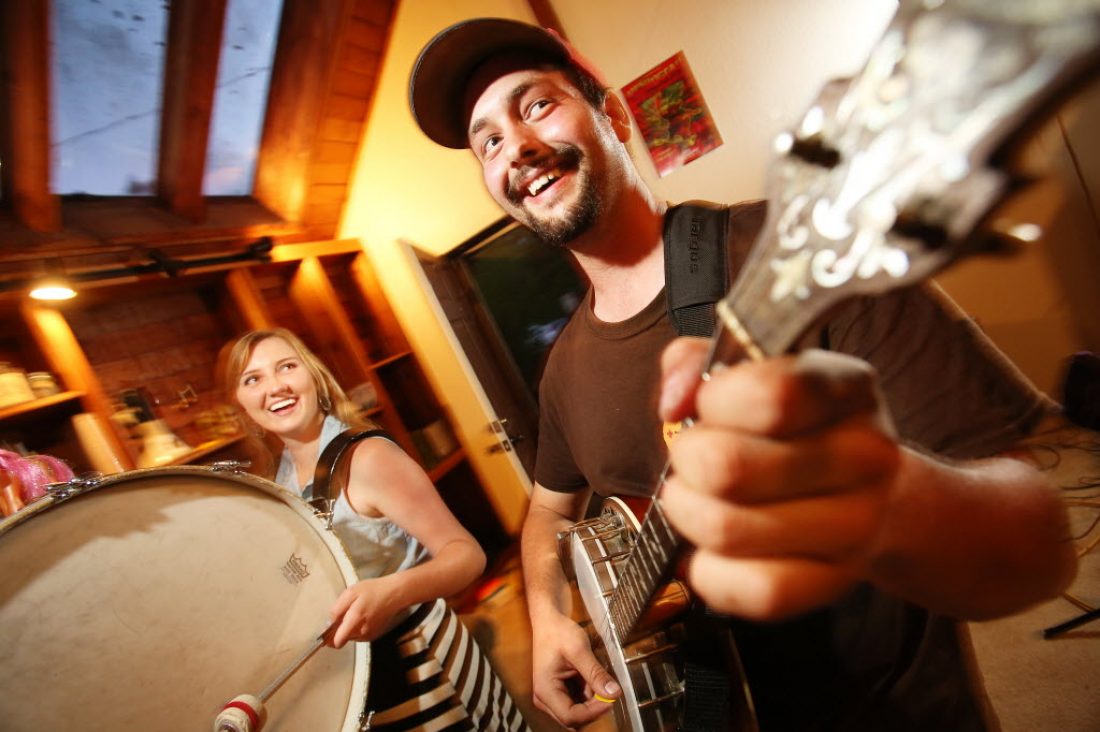By KATIE WATTS / Petaluma Towns Correspondent
A music scholar might describe Dixieland as one of the earliest styles of jazz, developed in New Orleans, an amalgam of brass band marches, French quadrilles, ragtime, blues and improvisation. But words can’t convey the infectious, toe-tapping, finger-snapping, hand-clapping joy.
For the past year, Petalumans lucky enough to be in the right place at the right time – Putnam Plaza, downtown on Mardi Gras, Ray’s Tavern among others – have experienced that joy courtesy of the Dixie Giants.
The group’s core members – Nick Pulley, Daniel Charles and Casey Jones – talked about the distinctive sound and how it came to the streets of Sonoma County.
Pulley, 26, and Jones, 24, are music teachers: Pulley in Sebastopol, Jones in Novato. Charles, 21, studies agricultural business and winemaking.
The origin was partly the Petaluma High School Dixieland Band, Pulley says. “I was student-teaching at PHS, and after the band went on tour to New Orleans, they told (band instructor) Cliff Eveland, ‘We have to have a Dixieland band.’”
Pulley goes on with a grin. Eveland said, “Fantastic. Ask Nick.”
Charles was a member of that touring band. Dixieland is about tradition, he says. “The music was on the streets everywhere, and we wanted to bring it back to Petaluma. Everyone’s happy when you go to New Orleans. The streets are alive.”
Later, when Jones wanted to start a Dixieland group, he was told Pulley “has all the music.”
Pulley mostly plays trombone, but also sousaphone and tuba. Jones plays clarinet for the Dixie Giants, but also saxophone, trumpet and euphonium. Charles is the group’s banjoist. Other band members include Paul Hanna (sousaphone), Adam Lessnau (trombone) and J.B. Duff or Ricky Lomeli (drums).
The majority of gigs have been in Petaluma, Pulley says. “It’s central, locals are the most receptive, and you don’t need a permit to play on the street in Petaluma or Healdsburg.”
What is it about Dixieland that audiences respond to? Pulley says, “It’s party music that allows a high level of communication. It’s energetic. You can’t help but get energy from positive music, and we get to improvise on the song. We’ll go places and have no idea where we’re going, but we’re creating this energy.”
“It’s like science,” Charles says. “We’re so high energy. Energy likes to travel from a place of high energy to low energy until it reaches equilibrium.”
Pulley laughs. “Hey, I’m a musician. I don’t know what that means. We never know how a song will end up. It will begin a certain way, and there will be some solos. That’s about it. Everything else is fair game.”
Jones recalls a day the group was busking in front of Cotati’s Oliver’s Market. “Some guy walks up and says, ‘Do you know any Bob Marley?’ Paul starts off the bass line, then both trombonists started in, I picked it up and we ran with it.”
He shakes his head, pleased. “Within four measures – not even 30 seconds – we had the bass, chord progression, melody and harmony. Six months ago it would have taken us a couple of days, maybe a week. But there’s that body language, that musical knowledge and,” he adds, “a lot of humor. With Dixieland, we can get all of us going and have a conversation.”
Pulley talks about an integral part of the music’s style, the “second line tradition, a whole other entity in a New Orleans funeral. The band plays dirges, ballads and hymns on the way in to allow family and friends to mourn and bury the body.
“But on the way out of the graveyard – it’s called the second line – there’s this switch to a major key. The music is more up, with a party beat. It’s a celebration of the life instead of a grievance of a loss. It’s a big part of this music’s culture.”
Jones mentions the klezmer influence on the music, which he learned at age 14 during a small klezmer show. (Klezmer is traditional eastern European Jewish music.)
“They told fantastic stories about playing in eastern Europe, and I asked the clarinetist how he played clarinet like that. He said the clarinet’s job in music is to laugh joyously or cry in sorrow, and you have to figure out which one.”
The band began as a hobby, playing in apartments and on the streets for spare change, but now, Jones says, “we’ve taken it to a level that’s fairly invested. We’re making serious connections across the country. It’s been good, but we never planned to get this far. We didn’t think it would last.”
Pulley says none of them know what the future holds. Right now, they’re simply having fun.
One of the places they enjoy playing is the Santa Rosa Farmers Market (at the Wells Fargo Center). “We were told we were the first band people applauded for,” Pulley says.
“People are dancing,” Jones adds. “One of the vendors is a swing dancer. He and his partner get other listeners dancing.”
“People tap into this music,” Pulley says. “The response is positive and playful.” And it’s reciprocal. The group’s enthusiasm feeds the band, “and when we’re singing, hollering and smiling, people catch on.”
In mid-June, they played in Santa Rosa’s Hooligan Street Faire, about which Pulley commented, “Playing and partying with brass bands until 3 a.m. is pretty much the best thing ever.”
To find out where the Dixie Giants will play next, Like them on Facebook: facebook.com/JpAndTheDixieGiants. Several members have summer commitments so performances won’t be as often in the next few months.
Does the group have a target audience?
“Do we have a market?” Pulley asks. “I never thought of a market. Who’s our target market?”
Charles says simply, “Everyone. It’s something everyone can enjoy.”

